How Wayne Linton’s Awareness Code Is Redefining Emotional Intelligence?

One quality that sticks out as a real game-changer in the rapidly changing leadership environment is emotional intelligence. It’s a basic skill that influences how leaders behave both toward others and toward themselves, not just a slogan. Wayne Linton is a part of this movement. His innovative work with The Awareness Code has changed the way emotional awareness is acquired and used in practical leadership.
In this blog, we’ll discuss how the Wayne Linton Awareness Code might enable leaders to access higher degrees of emotional intelligence and transform themselves into more successful, present, and powerful people in all spheres of life.
Define emotional intelligence, and then explain why it matters
In personal and business interactions, emotional intelligence (EQ) is the capacity to comprehend what type of emotion is present and then know how to move towards an inner experience of more control and personal power. Excellent EQ leaders inspire, create trust, and communicate—they do more than simply assign work. Underdeveloped EQ leaders, on the other hand, often lead to reactive decision-making, conflict, and misinterpretation.
According to Linton, emotional intelligence is a skill that may be developed rather than a set attribute. The Awareness Code assists leaders in developing self-awareness and emotional control at the core of EQ via a methodical and introspective process.
Introducing Wayne Linton’s Awareness Code
Developed by leadership strategist Linton and his colleague Steven Tappin, The Awareness Code is a practical model that maps out how leaders function emotionally across 10 levels of awareness. These levels are grouped into three core stages:
Disempowered mode (Levels 1–3)
At this point, leaders act out of fear, insecurity, guilt and shame They exhibit lifeless, despondent, and stressed reactions to both external and internal happenings.
Using force mode (levels 4-6)
Many leaders get caught here, functioning in wanting and controlling, self-centered ways. There can be some success, but it is often accompanied by negative consequences for self and others.
Learning to witness mode (levels 7- 8)
Leaders are mindful, grounded, and empowered to watch or listen without negative judgment. They lead with intention, presence, and a willingness to really connect and collaborate for the best win-win for all involved.
Wisdom mind (levels 9-10)
Leaders become so good at witnessing and connecting that answers that are outside the usual way of leading become more available. These leaders don’t have to try to be inspiring; they just are by the way they turn up in the two highest levels.
Linton’s methodology enables people to identify where they are working and gives specific strategies for increasing awareness and leadership effectiveness.
The relationship between self-awareness and leadership
Effective leadership begins with self-leadership; hence, Linton’s Awareness Code is based on this principle. If you are removed from your own emotions, triggers, and behaviors, you cannot effectively lead others.
The Awareness Code encourages leaders to accept responsibility for their internal states by
- Identifying recurring negative emotional habits
- Understanding what drives their reactions
- Developing the ability to pause and choose how they respond instead of just constantly reacting
- Leadership transitioning from reactive to reflective
This is where real change starts—not by trying to change other people by any of the lower 6 levels but by facing oneself with the attitude of “How can I change/transform to be a more empowered leader or person?”
The 10 levels of Awareness: A Path to Emotional Development
While the Awareness Code spans 10 distinct levels, its greatest strength lies in its simplicity. This technique can be used by anybody to monitor their development, from budding team leaders to corporate executives.
Wayno has worked with many CEOs and executive teams as well as all
levels down in companies.
Here’s a quick snapshot of the journey:
Levels 1–3:
Fear- and despondency-based. Leaders here feel victimized, overwhelmed, or rigid. Typical behaviors include self-blame, exhaustion, over pleasing, micromanagement, and emotional shutdown.
Levels 4–6:
Outwardly appears successful, inwardly strained. Leaders at this stage seek validation, control outcomes, or rely heavily on intellect while neglecting emotional depth.
Levels 7–10:
empowering, thoughtful leadership. These levels can be identified by their ability to lead with purpose, empathy, clarity, and gratitude.
Linton’s methodology does not pass judgment on your current situation; instead, it allows you to develop from it.
The Way Emotional Intelligence Is Displayed at Work
There are immediate and significant effects when leaders use the Awareness Code and improve their emotional intelligence. Teams become more unified. There is increased potential to manage conflict with grace. Decisions can be made with clarity and conscience.
Here are a few real-world signs of emotionally intelligent leadership:
- Reduced reactivity: Leaders respond rather than react, particularly under duress.
- Increased team trust: Team members feel seen, heard, and appreciated.
- Better communication: Emotionally aware leaders speak from clarity, not confusion.
- Increased self-regulation: Emotions are used as data, not roadblocks.
Linton’s framework makes this transformation tangible—helping leaders move from emotional autopilot to conscious influence.
Practical Ways to Use the Awareness Code
If you’re looking to build emotional intelligence, here are some simple ways to start using the Awareness Code today:
Check In With Yourself Daily
Ask: What am I feeling right now? Where am I on the Awareness Code scale? Naming your emotional state increases self-awareness.
Recognize Trigger Patterns
Notice when certain people or situations cause tension. Are you falling into control, blame, or avoidance? Transformation begins with awareness.
Shift from Reaction to Presence
Before responding, pause. Take a breath. Choose a response from levels 7 to 10 and practice daily.
Journal Your Emotional State
Keep a weekly log of your thoughts and triggers. Over time, patterns become clear—and so do opportunities for realizing the truth and therefore growth.
Commit to Progress, Not Perfection
It takes a lot of discipline and willpower to operate in Level 10 all the time. The goal is to keep growing towards these levels as best you can rather than creating failure for not being there when you slip.
Why Wayne Linton’s Work Matters Right Now
The world is changing rapidly, and leadership is being redefined. Technical skills alone are no longer enough. Organizations need leaders who are emotionally present, aware, and resilient.
Linton’s Awareness Code provides teams and people with the means to transcend antiquated leadership styles and create a more linked, aware manner of functioning. This approach provides a clear road to emotional emancipation, whether your leadership is managing a company, running a team, or negotiating personal development.
Final Thoughts
Unlocking emotional intelligence is more than simply regulating emotions; it’s also about mastering awareness. Wayne Linton’s Awareness Code provides a road map for doing just that. Learning to lead from presence rather than pressure not only makes you a better leader but also a more focused and content person.
In a society that requires calm, thoughtful leadership more than ever, emotional intelligence is not optional—it is required.














